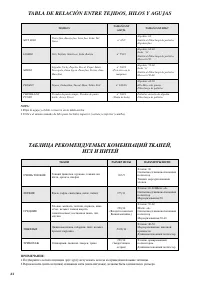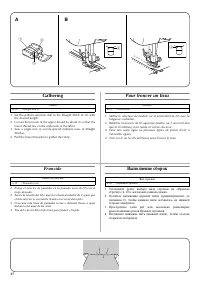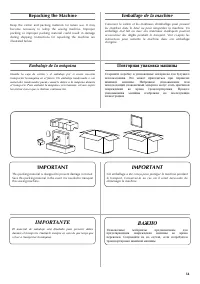Brother LS-2125 Máquina de coser – Manual de instrucciones en formato pdf, léalo en línea gratis. Esperamos que le ayude a resolver cualquier duda que pueda tener al utilizar el aparato.
Si aún tiene preguntas, escríbalas debajo del manual de instrucciones.
"Estamos cargando el manual" significa que debe esperar a que se cargue el archivo para poder leerlo en línea. Algunos manuales son muy pesados y el tiempo que tardan en aparecer depende de su velocidad de internet.

16
1. Raise the presser foot using the presser foot lifter and turn the
balance wheel toward you (counterclockwise) to raise the
thread take-up lever to its highest position.
2. Pull up the spool pin and place a spool of thread on this pin.
3. Pass the thread through both thread guides: the rear one first,
then the front one. (
fig. A
)
a
Spool pin
b
Thread guide (rear)
c
Thread guide (front)
d
Thread take-up lever
4. Pull the thread down and around the upper tension control
dial from the right to the left so the thread picks up the thread
check spring. (See
fig. B
.) While holding the thread as shown
in
fig. C
, pull it between the tension discs.
e
Upper tension control dial
f
Thread check spring
5. Guide the thread to the back of the thread take-up lever and
around to the left (
fig. D
). Bring the thread through the slit by
pulling it toward you and into the eyelet.
g
Thread take-up lever
6. Bring the thread down and pass it behind the thread guide.
h
Thread guide
7. Thread the needle from front to back and pull out about 5 cm
(2") of thread as shown in
fig. E
.
NOTE:
If the thread is incorrectly fed, the thread may break, cause
stitches to be skipped or cause the fabric to wrinkle.
1. Lever le pied-de-biche à l’aide du levier correspondant et
tourner le volant à main vers soi (dans le sens contraire aux
aiguilles d’une montre) pour remonter complètement le levier
releveur.
2. Lever le porte-bobine et y placer une bobine de fil.
3. Faire passer le fil par les deux guide-fils: d’abord l’arrière puis
l’avant. (
fig. A
)
a
Porte-bobine
b
Guide-fils (arrière)
c
Guide-fils (avant)
d
Levier releveur de fil
4. Tirer le fil vers le bas et le faire passer par le disque de
contrôle de tension supérieure de droite à gauche afin que le
fil attrape le ressort de vérification (voir
fig. B
). Tirer le fil entre
les disques de tension, tout en le tenant comme le montre la
fig. C
.
e
Disque de tension du fil
f
Ressort de vérification du fil
5. Guider le fil vers l’arrière du levier releveur puis autour vers la
gauche (
fig. D
). Amener le fil vers la fente en le tirant vers soi
et le faire passer par le chas.
g
Levier releveur
6. Tirer le fil vers le bas et le faire passer derrière le guide-fils.
h
Guide-fils
7. Enfiler l’aiguille de l’avant vers l’arrière et tirer environ 5 cm
(2") de fil comme le montre la
fig. E
.
REMARQUE:
Si le fil n’est pas installé correctement, il peut se rompre, causer
des sauts de points ou des fronces dans le tissu.
1. Levante el prensatelas con la palanca y gire la ruedecilla hacia
usted (en el sentido contrario al de las manecillas de un reloj)
para subir la palanca tirahilos a su posición más alta.
2. Levante el porta carretes y coloque un carrete en el eje.
3. Pase el hilo a través de ambas guías: la de atrás primero y luego la
de delante. (
fig. A
)
a
Porta carretes
b
Guía hilo (trasera)
c
Guía hilo (delantera)
d
Palanca tirahilos
4. Tire del hilo hacia abajo, pasando por el disco de control de la
tensión superior de derecha a izquierda de tal forma que el hilo
enganche el resorte de comprobación del hilo. (Véase
fig. B
).
Mientras sujeta el hilo tal como indica la
fig. C
, páselo por los
discos de tensión.
e
Disco de tensión del hilo
f
Resorte de comprobación del hilo.
5. Guíe el hilo por detrás de la palanca tirahilos y por la izquierda
(
fig. D
). Lleve el hilo por la ranura, tirándolo hacia usted y
pasándolo por el agujero.
g
Palanca tirahilos
6. Baje el hilo y páselo por detrás de la guía.
h
Guía
7. Enhebre la aguja de delante hacia atrás y saque unos 5 cm (2") de
hilo tal como indica la
fig. E
.
NOTA:
Si el hilo está mal enhebrado, puede romperse, saltar puntadas o
fruncir el tejido.
1. Поднимите рычаг прижимной лапки, пользуясь
соответствующим рычагом, и поверните маховик на себя
(против часовой стрелки), чтобы поднять рычаг
нитепритягивателя в крайнее верхнее положение.
2. Выяните вверх стержень для катушки и наденьте на него
катушку с нитью.
3. Пропустите нить через оба нитенаправителя: сначала через
задний, а потом через передний. (
рис. A
.)
a
Стержень для установки катушки
b
Нитенаправитель (задний)
c
Нитенаправитель (передний)
d
Рычаг нитепритягивателя
4. Протяните нить вниз и вокруг регулятора натяжения
верхней нити справа налево так, чтобы нить зацепила
ограничительную пружину. (См.
рис. B
.) Придерживая
нить, как показано на
рис. C
, протяните ее между
натяжными дисками.
e
Дисковый регулятор натяжения верхней нити
f
Ограничительная пружина
5. Направьте нить к задней части рычага нитепритягивателя
и далее вокруг него справа налево. Проведите нить через
прорезь, вытянув ее на себя, до попадания ее в ушко
нитепритягивателя (cм.
рис. D
.).
g
Рычаг нитепритягивателя
6. Опустите нить вниз и проведите ее за нитенаправителем.
h
Нитенаправитель
7. Заправьте нить в ушко иголки спереди назад и вытяните
около 5 см нити, как показано на
рис. E
.
ПРИМЕЧАНИЕ:
Если нить заправлена неправильно, она может оборваться, а
также могут пропускаться стежки или морщиться ткань.
¿Tiene más preguntas?¿No ha encontrado la solución a su problema en el manual o tiene otros problemas? Haga su pregunta en el siguiente formulario con una descripción detallada de su situación para que otras personas y expertos puedan responderla. Si sabe cómo resolver el problema de otra persona, ayúdele :)



























































